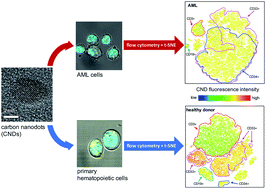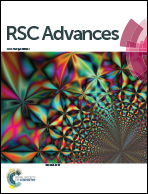Uptake of carbon nanodots into human AML cells in comparison to primary hematopoietic cells†
Abstract
Carbon nanodots (CNDs) comprise a class of next generation nanomaterials with a wide variety of potential applications. Here, we report on their uptake into primary hematopoietic cells from three normal donors and malignant cells from five patients with de novo acute myeloid leukemia (AML). A significant CND uptake was observed in all cell types of the normal and leukemic cells. Still, the uptake was significantly smaller for the CD34+ and CD33+ myeloid subsets of the malignant cell population as compared to the normal blood-derived CD34+ and CD33+ cells. For the T and B lymphoid cell populations as defined by CD3 and CD19 within the leukemic and normal samples a similar uptake was observed. The CNDs accumulate preferentially in small clusters in the periphery of the nucleus as already shown in previous studies for CD34+ progenitor/stem cells and human breast cancer cells. This particular subcellular localization could be useful for targeting the lysosomal compartment, which plays a pivotal role in the context of autophagy associated survival of AML cells. Our results demonstrate the usability of CNDs beyond their application for in vitro and in vivo fluorescence labeling or drug delivery into normal and malignant cells.



 Please wait while we load your content...
Please wait while we load your content...